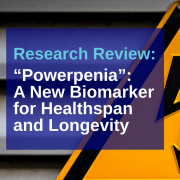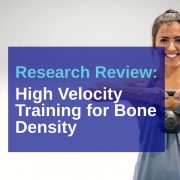Posts
Strengthening Bones with High Velocity Resistance Training (HVRT): A Guide for Those with Osteopenia and Osteoporosis
/in Bone Density, Training/by adminStrengthening Bones with High Velocity Resistance Training (HVRT): A Guide for Those with Osteopenia and Osteoporosis
For anyone managing osteopenia or osteoporosis, finding safe, effective ways to protect and strengthen bone health is critical. A recent systematic review, focused on high velocity resistance training (HVRT), provides valuable insights on how this type of training can benefit bone mineral density (BMD) in older adults—particularly at the lumbar spine, hip, and femoral neck, which are key areas prone to fractures.
What is HVRT?
High velocity resistance training (HVRT) is a form of exercise that combines speed with strength, emphasizing powerful, controlled movements that target muscle and bone. Unlike traditional resistance training, HVRT often involves quicker concentric (lifting) movements paired with slower eccentric (lowering) movements, which engage the muscles attached to bones in ways that promote bone health.
Key Findings from the Review
This review included 25 studies, totaling over 1,200 participants. Here’s what it found:
- Small but Significant Gains in Bone Density: The review found that HVRT programs, when performed twice or more weekly, had a significant positive impact on BMD in older adults. Increases ranged from 0.9% to 5.4%, primarily in the lumbar spine, femoral neck, and total hip.
- Consistency is Crucial: Importantly, studies showed that BMD improvements were lost if exercise was stopped for six months or longer. Thus, consistency is essential to maintaining gains.
- Multimodal Programs Enhance Outcomes: Programs that combined HVRT with other exercises, such as balance and flexibility work, tended to show even better results. This blend of exercises seems to create a synergistic effect that further supports bone density.
- Longer Duration Leads to Better Results: Programs lasting six months or more tended to yield the most notable BMD improvements. Bone remodeling is a slow process, so longer-term commitments to HVRT are recommended.
Practical Takeaways for Improving Bone Health
1. Consider HVRT as Part of Your Routine
- Minimum Frequency: Aim for at least two HVRT sessions per week.
- Duration: Commit to at least six months of consistent training to see meaningful changes in bone density.
- Controlled Environment: HVRT is best done in a safe, supervised setting, such as with a trainer experienced in osteoporosis-friendly exercise regimens, especially for those new to resistance training.
2. Blend HVRT with Other Exercises
- Including balance exercises, flexibility work, and moderate-impact activities (like walking or light jogging) can amplify the osteogenic effects of HVRT, helping to strengthen not only bones but also the muscles and ligaments supporting them.
3. Avoid Long Breaks
- If you stop training for six months or more, you risk losing any gains in BMD. Schedule your workouts as part of your weekly routine, and avoid long gaps to maintain bone strength.
Making It Work for You: Safety First
For many, the idea of high velocity training can sound intimidating, especially if you’re managing a condition like osteoporosis. However, HVRT can be modified with machines or lighter weights to accommodate different ability levels safely. Additionally, explosive movements can be adjusted to fit your fitness level—there’s no need to engage in highly intense or Olympic-style lifting to benefit from HVRT.
Beyond Bone Health: Preventing Sarcopenia and Powerpenia
Alongside improving BMD, HVRT may also help prevent sarcopenia (age-related muscle loss) and powerpenia (decline in muscle power). Sarcopenia and powerpenia are serious issues for older adults, leading to reduced mobility, higher fall risk, and overall decreased quality of life. HVRT, with its focus on explosive movements, can help retain both muscle mass and power, essential for everyday tasks and fall prevention.
For more on powerpenia read our full article here.
Take Control of Your Bone Health
For those diagnosed with osteopenia or osteoporosis, HVRT offers a promising, science-backed way to take control of bone health. Start by consulting with your healthcare provider and a qualified trainer who can help design a safe, effective HVRT program tailored to your needs. With commitment and the right guidance, you can build a sustainable exercise routine that strengthens your bones and supports long-term health.
Let’s build stronger bones—starting today!
C
REFERENCE: Haque, I., Schlacht, T. Z., & Skelton, D. A. (2024). The effects of high velocity resistance training on bone mineral density in older adults: A systematic review. Bone, 179, 116986. https://doi.org/10.1016/j.bone.2023.116986
PEAK FORM NEWSLETTER SIGN UP
Our Office




